#Daggerheart daemon
Explore tagged Tumblr posts
Text
Dipping my toe into the Daggerheart play-testing… Mollymauk/Kingsley is here!! That’s him!!

#why did no one tell me#daggerheart#critical role#mollymauk tealeaf#kingsley tealeaf#Mollymauk#Daggerheart daemon
260 notes
·
View notes
Text
Hey hey, look who's the example for Daemon ancestry in the Daggerheart open beta:
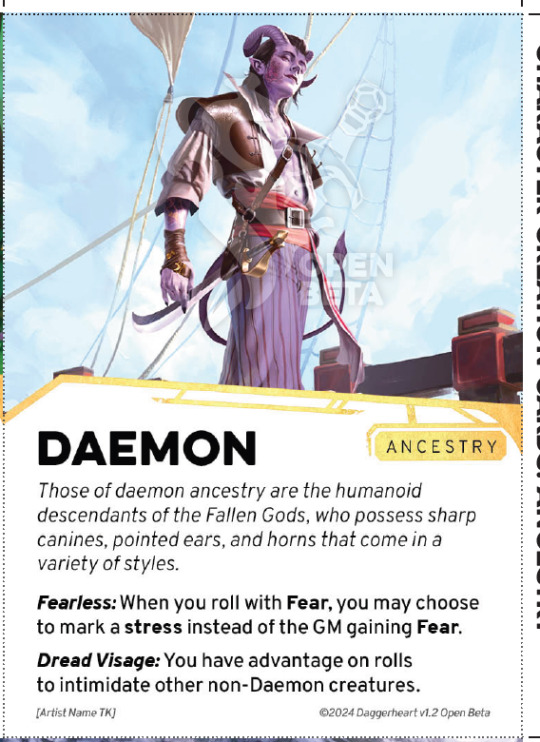
#critical role#daggerheart#kingsley tealeaf#what happened to your coat King?#actually wait it could probably be any of the three huh?#there's some design elements reminiscent of each#mollymauk tealeaf#lucien critical role#Molly's tattoos#Lucien's hair#Kingsley's pirate feel
54 notes
·
View notes
Text
Daggerheart - What I've Seen So Far
Template-Based Character Builds
This will be familiar to players of D&D, Pathfinder 2e, Monster of the Week and similar systems where you choose from one of several existing classes, playbooks, ancestries, backgrounds, and the like.
The selection of templates here come in three categories:
Classes
Ancestries
Communities
Classes
Classes are built along lines familiar to D&D players with the following options.
Bard
Druid
Guardian
Ranger
Rogue
Seraph
Sorcerer
Warrior
Wizard
Most of these are what they appear to be, with Fighter and Barbarian bundled together across Guardian and Warrior, with one being more tanky and the other being more damage oriented. Cleric and Paladin are represented together by Seraph.
Each of these classes has subclasses similar to D&D with each currently having two options. These subclasses start with a "Foundation" ability, moving to "Specialization" and then "Mastery". I'm curious at this moment whether in the future each subclass will have multiple Specialization and Mastery options but currently there's only one to each subclass.
Each class also has two "Domains" which determine the selection of other skills they can draw from. This has similarities to both City of Mist's themebooks, with the exception that the Domains are hardlocked to each class, and Pathfinder's Class feats, with the exception that each class is going to overlap their abilities with other classes.
For example, Warrior and Ranger each have access to the "Bone" Domain abilities while Druid and Sorcerer all have the "Arcana" Domain.
Initially, a character will have two of these abilities but they will get more as they level up, with the ability to have at most five active at any given time, with a cost to switch abilities out if you suddenly decide you need X instead of Y.
This smacks a bit of Vancian casting, spell-slots and the like, however there are two closer mechanics, one of these also from Darrington Press. In Candela Obscura you have a list of items which you can declare you have at any point, but only up to three-items. Then there's Scion 2e, where you can buy as many Knacks as you want, but you can only have a number active equal to your ranks in associated Callings.
Ancestries and Communities
These represent the character's genetic heritage, what D&D currently refers to as Races. These have a basic ability like a Daemon's "Dread Visage" helping them to intimidate others. At current moment, there doesn't appear to be a list of future abilities connected to Ancestry similar to Pathfinder's Ancestry Feats.
Similarly, Communities are similar to Backgrounds in both D&D and Pathfinder and come with a similar power to those found in Ancestries. Again, there doesn't seem to be a sign of other powers based on Community as you level up. But this is no different from Pathfinder or D&D.
Analysis
It's familiar enough to D&D and Pathfinder that a lot of people are going to be comfortable with it. The use of cards feels a bit like a gimmick, but I imagine it will make parsing through abilities a bit easier for a lot of people since you can cut down to just your abilities rather than look through the entire book. Assuming more abilities get put out as the game moves on, this is essentially not too different from D&D/Pathfinder Feats or Scion Knacks.
From a design perspective it's also a good move since new classes will only require building the basic class features and subclass features and the majority of the abilities will come from the same pool.
All in all, it's easy for D&D players to pick up and appealing enough to those of us whose home games are more of the narrative variety.
Health and Defense System
The Health System is probably the most innovative part of this game.
First, the parts of the system that are elements I've seen before:
Separate Evasion and Resilience is a thing that has been around for ages. Champions/Hero System has done it since the early 80s and it also shows up in Storyteller, Storypath, Cypher system, Mutants and Masterminds, and so on.
The combination of Stress and Wounds is also something I've seen before. Notably in City of Mist and Fate.
Armor as a resource that gets expended also is something I've seen in The Fellowship, Scion 2e, and several other such things.
Capped damage... and this is initially the one that stood out to me as the that's cool... appears in Scion 2e where the most you can deal with any attack is 2 Wounds... in a game where one Wound is enough to take out most enemies.
Low Health totals are a common build design for PbtA games, Fate, Scion 2e, World of Darkness, City of Mist, and several other games.
It's the Damage Thresholds added in here that makes this most interesting thing and where it avoids the pitfalls that affect some of these other systems (note that Fate, MotW, Scion 2e, and City of Mist are the systems I consider my "home games" so yes, I'm pointing out their pitfalls.
The Damage Thresholds allow for the fun of rolling huge numbers and building significant differences between squishies and crunchies without making balance too difficult.
Capping the damage at 3 where all players have 6 HP at base means that you're never going to have a player be one-shot. It shares this feature with Scion 2e. Though Scion 2e has the options to spend extra success on other things beside damage, so allowing for a more scenery chewing, cinematic, superheroic style of fight (the developers of the game point to the fight between Kratos and The Stranger/Baldur at the start of God of War as what they wanted for Demigod tier combat).
However, the Damage Thresholds and rolling damage are likely to be more intuitive to players only familiar with D&D.
PbtA matches low Harm/HP counts with static damage: a knife will always deal 1 Harm, for example. Similar to Scion 2e, this prevents characters from being taken out in one blow ... you know, unless the static damage is something like 6 or 8... which feels like a bad choice on behalf of the GM. But not rolling damage can be a little jarring the first couple of times you encounter it.
Those are minor issues. Scion 2e, City of Mist, Monster of the Week, and Fate were all built in a world where the big risks were already apparent and demonstrated. The differences between them and Daggerheart is significant, but which you prefer is largely going to be a matter of preference.
Hero System and old Storyteller system is where the danger of separating evasion and resilience. Hero System tanks become incredibly difficult to damage even when you do hit them because their resistances cancel out all the damage. Building attacks to get around that tends to be expensive. Likewise, high Speed or Defense characters can be just impossible to even touch... though you can counter that with area effect attacks.
In a lot of Storyteller (World of Darkness, Scion 1e, etc) systems Dexterity got marked as a "God Stat" usable for both attack and defense and where their armor mechanics were far less reliable.
Daggerheart gets around both those major balance issues. It does have the potential for some psychological downside in that rolling especially high damage rolls may feel like you're wasting effect. However, it looks like part of how they do multiple attacks or area of effect is let you roll damage and split it up between multiple attacks as you desire. So if you did a massive amount of damage, you can apply the bulk of the effect on a main enemy and scatter the remaining damage to several of the minions around them.
As far as resisting goes... a Warrior is going to be a lot harder to damage once you hit them than a Rogue, but they will still have to deal with being slowly nickel and dimed down. High Evasion characters will avoid most attacks, without the risk being pasted by a single strike.
This reduces the scenario design burden on the GM since they don't have to worry as much about overwhelming the tanks or flattening the dodgers (or casters) in a single roll.
Death Move, not Taken Out
One side note is that Daggerheart does not use a Taken Out mechanic. When your HP go to 0 you have three options:
Go out in a blaze of glory.
Risk a scar and resist death, scars are more likely the higher level you get.
Risk it all and roll hoping your Hope die is higher than your Fear die at the risk of dying flat out.
This is in comparison to Scion 2e and Fate where getting Taken Out mostly just means that you are out of the scene and death is a matter of choice and negotiation between player and GM. This presents the players from being blindsided by death and getting drama out of defeat such as being captured or separated from the group. Or... they can let their character die if they feel it is narrative enough.
Daggerheart similarly has ways to avoid death blindsiding the group and derailing campaign progress with the need to introduce a new character and the loss of story arcs that had been built up. But death still remains a risk, similar to City of Mist or Monster of the Week. (Though Monster of the Week has a significantly dramatic resurrection mechanic.)
Action Resolution System
The d12+d12 system is a bit interesting. You roll 2d12, each a different color called "duality dice". One of the dice is Hope and one is Fear. If your Hope die is higher than the Fear die, then you gain a Hope (the meta-currency of the game), but if the Fear die is higher, the GM gains a Fear (the GM's version of Hope). If the two dice are equal, that's a critical success.
They list Genesys as a Touchstone, and I can see its DNA here. Genesys uses a number of signature dice and you roll large dice pools of positive dice versus large dice pools of negative dice generating and cancelling out resources. It was not nearly as bad as I expected it to be and, in fact, I found it quite a fun system to play, but it is intimidating to a newcomer. Heck, as implied, I was doubtful of it before I played it.
This is more similar to rolling Fate dice where you roll 4d6 where the sixes are each marked with 2 blank, 2 minus, and 2 plus sides. Add those together and you get a range of effect from -4 to +4. But again, they haven't listed Fate as a direct Touchstone, so I don't think this is deliberate. If it was Hope minus Fear the comparison would be almost exact.
As a note, this d12+d12 method creates a slightly higher chance of getting a critical hit. As seen here in an Anydice comparison, the chance for a critical hit on this method, where the dice roll the same number, has an 8.33% chance of success compared to a 5% chance with rolling a natural 20... and no chance for a critical failure.

The "with Hope" and "with Fear" also allows the GM to describe a success that yet promises coming danger (succeeding with fear) or a failure that yet gives a sign that all is not lost (failing with hope).
As a note, it appears that the GM rolls a d20 instead of d12 + d12. This means that they have a narrower and more swingy success rate compared to the far more consistent and reliable PCs. PCs are going to find their results cluster around a die roll of 13, making bonuses more impactful. This is a benefit of game systems that don't use a flat curve (single die).

The choice to make rolling pairs the critical hit result neatly avoids the downside of crisis resolution methods that avoid flat curves where critical hits are either very rare or else come about as a result of a player just spending tons of resources at once to turn a good roll into an amazing on as happens in Fate (granted, I love that a lot of the success and failure of Fate is hinged more on the player choice to spend resources than on random chance, but there is something to be said for the natural 20 moment).
Speaking of Fate and spending resources, this is the point where I point out that Daggerheart is a Fortune-at-the-End system. To explain this:
Fortune-at-the-End: Barring a few special abilities, the die roll is the last step of an action resolution. Spending resources comes before you roll. D&D is Fortune-at-the-End
Fortune-in-the-Middle: Rolling the die is a middle step and the player can choose to spend resources after the die is rolled. Fate is Fortune-in-the-Middle.
Fortune-at-the-Beginning: Rolling a die would come at the start of the action, generating resources which the player then spends to accomplish things. 7th Sea is Fortune-at-the-Beginning as in it you roll dice at the start of a scene to generate "Raises" which are then spent as the scene moves forward.
A good way to describe it is as follows:
In Fortune-at-the-End when you are jumping a chasm, you gather yourself up and rush forward and then leap. The die roll happens once you are in the middle of the air and unable to do anything to alter the results.
In Fortune-in-the-Middle, you move forward taking some preparations, but die roll happens at the last possible moment you have to abort the choice. The die roll then basically determines just how much success is going to cost you. Do you abort and stay on this side? Or do you risk a minor injury to hit the other side? Will you need those resources later?
In Fortune-at-the-Beginning, the die roll happens before you decide to jump and you check to see if your roll gave you enough resources to make the jump... and then judge whether making the jump would leave you vulnerable to consequences.

I tend to favor Fortune-in-the-Middle game play and have even tended to treat D&D 5e with Inspiration (when I remember it) as a Fortune-in-the-Middle situation. I also allow players to take the Help Out move in Monster of the Week in response to other players rolling poorly.
There's a psychological element to knowing that your failure comes because you chose not to use the resources to succeed and there's a question as to whether or not you made the right decision. Especially if you choose to spend and later find you lack the resources you need to follow through to completing the overall objective. To me, random chance deciding failure can feel just frustrating... but with this, it's my choice that caused the fail.
However, I'm not inherently opposed to Fortune-at-the-End.
Narrative Initiative
Daggerheart uses a Narrative Initiative style, this means that there is not a set turn order as you would see in D&D. Rather, the characters take actions as the players at the table, including the GM, feel that it makes sense for actions to occur.
Some versions of Fate use this method, but by and large the most common style of gaming that does this are Powered by the Apocalypse games and their descendants: Forged in the Dark or... it doesn't really have a generalization since only Son of Oak is designing with City of Mist's system... but lets call it "Made in the Mist".
Scion 2e uses initiative where there are Hero turns and Enemy turns, but the Heroes all choose who goes in which turn, so in one round, the players can decide the child of Kali takes the lead while the child of Loki sets up and then reverse that order next time where the child of Loki takes advantage of the set up to give the child of Kali an opening for a big hit.
This is probably where most players are going to have the most confusion about "whose turn it is". I've already seen second hand people responding to statements of "if there's no turns then it's not a game." But again, I point at the fact that there are numerous games that now play exactly this way.
Meta-Currency
There are several Metacurrencies in gaming. In fact, when you come down to it, most RPGs run on meta-currencies including D&D with it's spell-slots, hit points, and action economy, but mostly when a gamer refers to "meta-currency" they are going to be talking about points which are used to modify rolls or trigger effects.
Fate Points might be the ur-example of this type of meta-currency, but there might be something older. Fate points are used to activate Aspects either to make a task easier or harder. Both players and GM get Fate points to do this, and they can also use Fate points to add narrative elements.
Scion 2e basically does this but names the player meta-currency "Momentum" and the GM currency "Tension". 7th Sea has "Hero Points" and "Danger Points". Fabula Ultima has "Fabula Points" and "Ultima Points". But where they name Genesys, I'm suspecting they are coming at this from there and the original version of Genesys: Star Wars FFG with it's "Light Side" and "Dark Side" points.
One of the key things that make Meta-Currency work well or poorly is in managing the economy of the points.
Fate Point economy is largely controlled by the GM and players and it can be difficult to manage. Fate Points refresh at the start of each session but are also gained by suffering inconveniences based on your Aspects. However, Fate Points are so central to the game and most Fate advice points out that the game's success hinges on making sure to keep Fate points flowing into the characters as well as making it clear to the players that when they play up the downsides then they generate resources.
In Scion 2e, Momentum is gained when the PCs roll poorly or suffer consequences from their injuries or other conditions and Tension is generated when the PCs accomplish some success, keeping a good ebb and flow between the heroes and the villains.
7th Sea, Fabula Ultima, and Genesys also all have very clearly defined ways that the meta-currency is generated.
The only meta-currency strict D&D 5e only players probably have encountered is Inspiration which is basically a Fate Points poor cousin. It feels largely tacked on and the method of gaining is so poorly sign-posted that it was almost a decade of playing the game before I learned that you're supposed to get Inspiration when you play up the personality traits from your character's Background.
So, D&D players have experience with a poorly implemented, largely unnecessary to its system, and forgettable metacurrency. This has caused the idea of metacurrency to have a bad reputation with some gamers. So Hope and Fear may be a point that generates doubt and concern from some potential players.
That said, Hope and Fear are generated in very clearly outlined methods and they are both very central to the game so that they are not easily forgotten the way Inspiration is.
Overall
Daggerheart draws from a lot of sources in terms of mechanics, but it so far blends things together quite well and most of the mechanics are fairly well-trodden ground, often with at least a decade of prior history.
I've seen games that cobble together mechanics from multiple sources rather shoddily... the 1st edition of Numenera comes to mind. This beta is much better condition that that game was finished.
It looks like a good half-step between games like D&D and narrative games. Probably hitting in the same general region as three of my home games (Scion 2e, MotW, and City of Mist) but just closer to D&D than Fate (my fourth home game).
35 notes
·
View notes
Text




This is my Daggerheart party 🩵⚔️ these are the character drawings I did after session 0, meet:
Cerys the faun sorcerer
Kentaka the daemon warrior
Lazuli the Druid faerie
And Bangali the rogue katari
I can’t wait to draw and explore more of these characters and share them 🐯🔮🩵⚔️
#fantasy#fantasy art#daggerheart#daggerheart art#oc art#my ocs#dnd art#character design#dnd character#character art#original character#digital art#digital drawing#digital painting#digital aritst#artists on tumblr
14 notes
·
View notes
Text
if you go with the serpah class and play a daemon then you can literally just be a tiefling with angel wings in daggerheart and I think that's very fun
15 notes
·
View notes
Text


He’s running from a shadow that has stalked him all his life It’s the darkness that is lurking when you feel like you’re dropping out of sight Well he’s torn himself to pieces and each night he feels the itch To grab the needle, thread and scalpel He’ll gather, slice and stich And he’ll build a brand new person where the current person sits Until he’s nothing but a patchwork of other people’s greatest hits
Sometimes you a design a ttrpg character to be a little too babygirl and now you're obsessed with them <3
This is Vesper and he's my Daemon Rogue in @osameowdazai's Rosewood Daggerheart Campaign. And he's also my blorbo from my brain because HHHHHH I love him. He's only a little fucked up if you ignore all the baggage.
(Lyrics are from Gene Kelly by Felix Hagan and the family courtesy of @pmreaper)
12 notes
·
View notes
Text
9th Game - Daggerheart (Beta) - Epithet

As I watch (well, listen to) the Critical Role video on how to make a character in Daggerheart, I figure, I should make this my 9th gorgon archer (in this incarnation at least).

Now, as a caveat, there is certainly not a gorgon ancestry, nor are there any snake people. Also, as a game that is beta, there's not a lot of the usual options I'd lean into for making a full on gorgon, so this is going to be my first epithet character in this version of the Gorgon Archer blog.
So the first thing we're going to do is pick class. Well, first I'm going to pick a name, and I think I'm going with Cael, my playtest gorgon sorcerer for D&D 5e, and use the level 5 picture I have of her. And the first thing, we're going to do is pick a class.
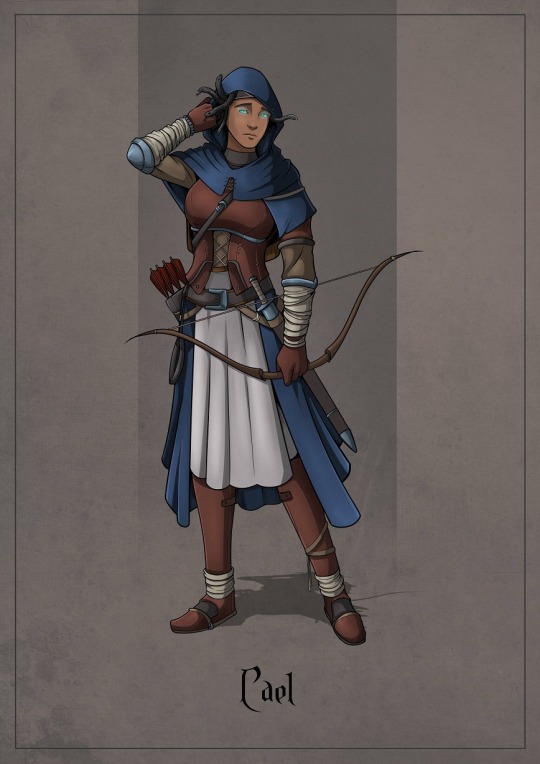
I know, I said this would be an epithet... but I'm still using the literal gorgon portrait.
Step One: Heritage
So, we're now going to pick Heritage which is the combination of your genetic ancestry and your communal upbringing.
Since I went with Cael's picture, I'm going to go ahead with Elf since Cael is a wood elf. The options I was thinking were elf, human, or orc. Daemon was considered, and if the horns were considered less of a set-thing and you just had to do something inhuman pointing to demonic heritage (like the 2e tieflings, which didn't need to have tails), I'd have chosen that.
Actually, you know what, let's ignore the horns thing and the fact I'm using an elven gorgon for the portrait and let's go with daemon and say her inhuman trait is snakes for hair. (I am now officially crossing out the word epithet... but leaving it up there for historical purposes).

Oh..... I didn't even read this.
Dread Visage is so very much a gorgon thing!
Excellent.
Okay, next we go with their community which is where you grew up. What options we have include:
Highborn - A community focused on nobility, luxury, and prestige.
Loreborn - A community focused on academia, politics, and knowledge
Orderborn - A community focused on faith, discipline, and order.
Ridgeborne - A mountain community.
Seaborne - An ocean or otherwise waterborn community.
Slyborn - A community featuring a lot of criminal or shady activity.
Underborne - An underground community.
Wanderborne - A nomadic community.
Wildborne - A forest community.
Looking at my other gorgon archers, I've had things along the lines of Order, Wild, Order, and Lore. I think for this one... we're going to go with Wanderborne and say she grew up in a wandering merchant caravan.

Step Two: Class
Now, how to represent the archery. Rogue and Ranger both seem to fit this, but with the gorgon thing, I think I'm going to lean into the snake thing and go with Ranger.

And we're going to go for the predictable Foundation of "Beastbound" so she has an animal companion. Guess what kind of animal it is. Three guesses, the first two don't count... it's a python.
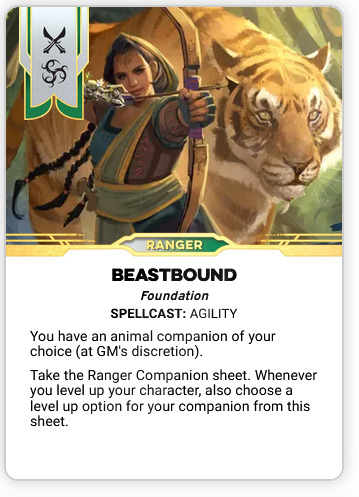
We're going to name this companion Euryale, Medusa's sister, and it would be "Yuri" for short. And we're going to mark two companion traits she has. The options are:
Sneak
Climb
Strike
Scare
Run
Fly
Leap
Swim
I think we'll want to pick Strike as a basic ability, and for the second one, we're going to go with Climb. Scare is very appealing, but I think it's a good idea to give Yuri some movement and attack options here. Now, I could have done a smaller snake to begin with and chosen Sneak and Climb. Something to think about. But I like the idea of an absurdly large snake-friend.
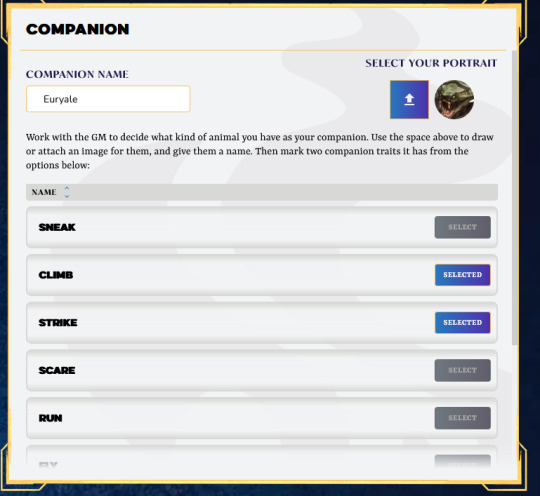
Now, we pick the traits, the recommended is Agility +2, Finesse and Instinct +1, Strength and Knowledge +0, and Presence -1... I think I'm going to play this up a little and take a +1 Presence, she's a likeable gorgon, and a -1 to Strength. If she needs to break something, she has Euryale for that.
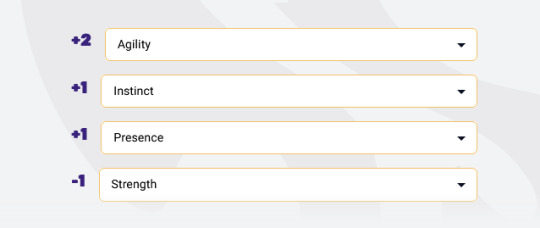
The next part of Class is choosing starting weapons, and we're definitely going with a Shortbow. It is the recommended option, but also the Longbow in this session is cumbersome, which impacts evasion and I want her agile and slippery.

We also need a secondary weapon. Which... I see whip... I'm taking whip.

And for starting armor, we're going to go with the recommended and take Leather Armor.

For starting gear we have a torch, 50 ft of rope, basic supplies, a handful of gold and two choices:
A choice between a health potion and a stamina potion.
A choice between a trophy from your first kill and a seemingly broken compass.
I'm going with the Stamina Potion, I may regret that later, and the interesting idea of the seemingly broken compass. It has Jack Sparrow vibes to it.
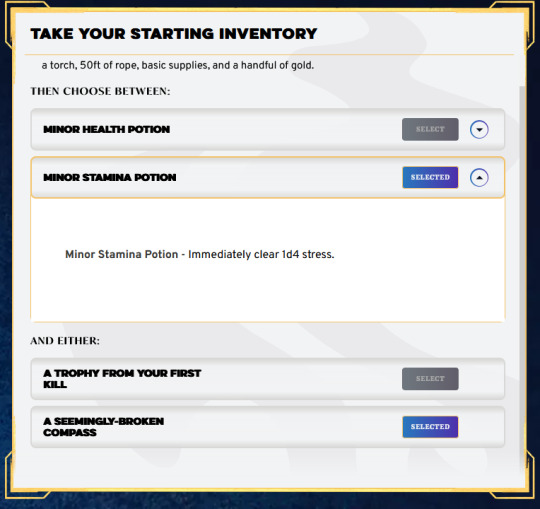
Next we choose our character's "Domain Deck Cards" these appear to be class skills and the like. The Ranger's domains are Bone, which seems to be about strategy and battlefield control, and Sage, which is the domain of the natural world.


Every class features two Domains, so there will be overlap with other classes in some cases. Druid will have Sage, for example, and Warrior will have Bone. There are six cards available to this version of Cael as a starting character.
Deft Maneuver - spend Hope (liquid currency in the game) to move far very quickly.
Gifted Tracker - roll to track or ask the GM a question about a specific creature or group.
I see it Coming - spend hope to roll a die to add to your Evasion
Nature's Tongue - speak the language of the natural world
Nimble - passive add Nimble to Evasion while the card is in your loadout
Vicious Entangle - roots and vines restrain a target.
I think I'm going for Nimble, I do like passive increases.

And I want a bit of Sage too, so I'm going to grab Nature's Tongue, so she can talk to all the animals.
Side note, this version of Cael is a lot more happy and less suffering from terrible memory retention issues due to magical abuse.
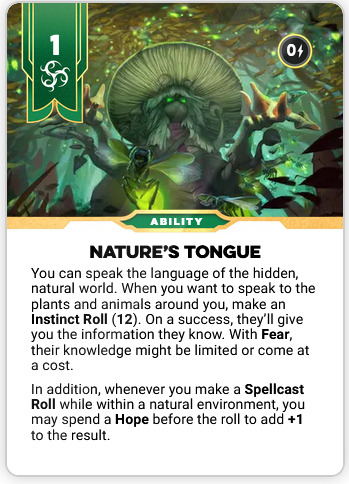
Step Three: Experiences
This gets into your character's backgrounds. We start with description, and I'm leaning into this being an alternate version of Cael whose heritage didn't erupt out of trauma.
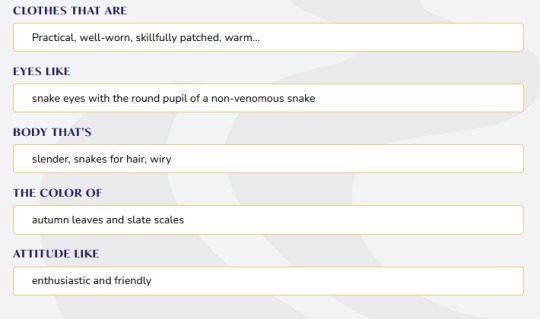
Well, I've found a bug on the character creator:

Anyway, answer the background questions hmmm.
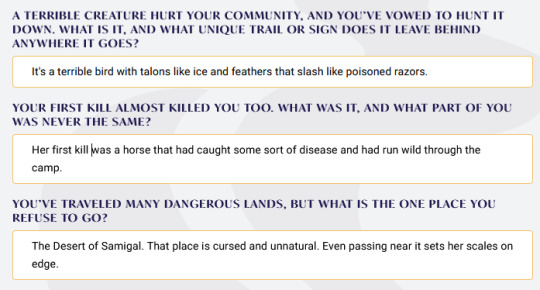
Experiences seem to work a bit like Aspects in Fate, you name something like an occupation, skill, specialization, or catchphrase which are used to represent skills you earned from that background.
We are going to have two, one at +2 and one at +1. And I think I'm going to make it Pathfinder +1 and Friend to the Beasts +2 EDIT: I just realized that these Experiences are so much like Aspects that I could name one "Gorgon" so I'm going to change out "Pathfinder" for Gorgon.... and probably pickup Pathfinder later on.

And then you choose some ways you're connected to other characters in the party.
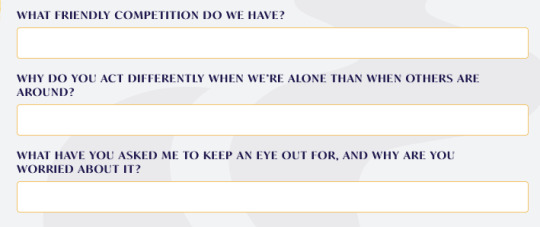
I'm actually going to leave this one blank for now, in case I get a chance to play this character.
And in the end this is what the character looks like:
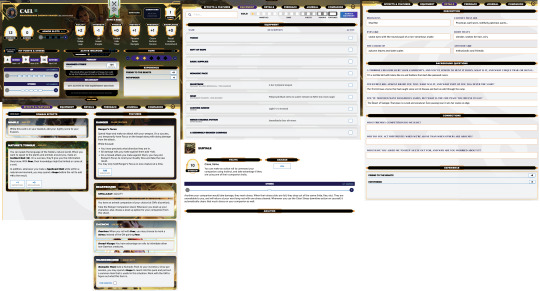
I went ahead and filled out their survey, but didn't feel great about it since this was purely about character creation and the questions were assuming a full session being run. EDIT: I went in and marked her equipment active.
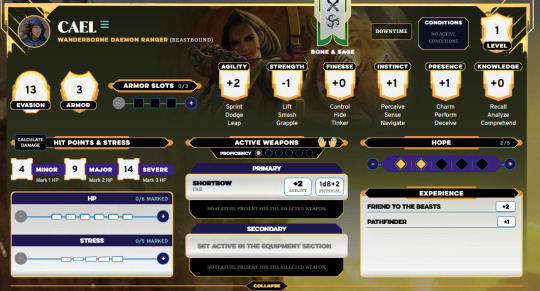
As a note, I haven't read the rules yet, just character creation. So I'm not sure how a lot of this will play out, but the use of Stress and HP reminds me of Legend of Five Rings' Strife mechanics a bit... just on the face of it at least, again I haven't played the game or read through it... It also reminds me of the language of Fate.
Now, there isn't much that's mechanically supporting the "gorgon" part of this... except for the "Dread Visage" thing, but still pretty happy with this.
#character creation#roleplaying games#tabletop roleplaying game#gorgons#tabletop rpg#gorgon archer#ttrpg#archer#tabletop rpgs#gorgon#Daggerheart#beta#critical role#darrington press#playtesting#playtest
6 notes
·
View notes
Text




now that my nda is done i can share ... can't draw so i made my daggerheart blorbo in the bg3 character creator!!!!
nyx (they/them), underborne daemon + nightwalker rogue. on the run from their hometown's town council and their own family after a heist gone extremely wrong. left behind a lover and a beloved pet when they fled. current gold medallist in the lying and sneaking and manipulating olympics <3
#daggerheart#i love them soooooo dearly. my first character in any system is always a rogue and i always love all of them#nyx especially is like. clever of mind dumb of ass weak of arm <3 and so charming#nat.txt#n; rpgs#in general i think daggerheart looks like it has a lot of potential!! i love the collaborative and often player-led worldbuilding stuff#and i'm intrigued to see how it translates to online play as well!! nice that they have it set up in demiplane already
1 note
·
View note
Text
What a fun character concept! Thaaank you for the answer! <3
I'm having such a good time playing Daggerheart! And making silly lil mushroom jokes.
My lil fungril Bard Troubadour Juno Amanita from the Sept de Coeur. Their magic looks like lil smaller mushrooms with knives or musical instruments. I have used the phrase "you cannot kill us in any way that matters." I am having so much fun.

We all chose lil guys so we decided humans, elves and dwarves blew themselves up (the remnants are all descendants of the monster fuckers like some daemons and some katari, and some mutants and wizards in cellars) we are exploring their ruins and have a giant salamander who has a giant snail shell backpack that has all our stuff in it. We give them, Berdie, all the good cosmetic gear. The goodest boi. He has a lil tiara and a magic bandana.
When I was telling my brother about my crisis re: do fungrils have bones he was like 'you should ask Aabria, she should probably know.' And like yes, but then I was like, 'oof maybe I should finish watching the menagerie content and see if they already answered that question for Sweetpea.'
And that's why I remembered to subscribe to Beacon.tv. (and then forgot to watch because I'm so stressed with my move that I had to watch British people charmingly do and solve murders)
422 notes
·
View notes
Photo

AMRAK DAGGERHEART
One of the original Noise Marines who beheld the beautiful corrupting horror of the Maraviglia upon the flagship of the Third Legion, the Emperor’s Children. That horrific scene forever scarred and maddened Amrak, even ten millennia since the Horus Horus - he strides as one of journeymen to hunt for that Perfect Song.
Above the Long War. Above the legions’ self-destructive politics. Abaddon’s calls mean nothing to him, only the honour of Slaanesh and his ascended Primarch.
A warlord that claim followers in his bounded kakophoni and those who worship their unified song, becoming only known as the Daggered Choir, Amrak’s name came from the prophetic meeting of an Eldar who suffered under his dirge that left a piece of crystalline dagger-tip in one of his twin hearts.
He will gain what he seek and lose what he sought, it said.
And Amrak wore his face ever since over his helm in gratitude that he was in the right direction.
Armed of daemonically-enscrolled power sword and the shrill-singing of a plasma pistol, the Slaaneshi Lord stride with a great Doom Siren upon his back as a living nexus of debauchery towards his Path of Glory.
Based on basically my first bought model of an old Emperor’s Children noise champion/lord and so make him apart of my character rostor. Took a long while to get this boi down on paper.
20 notes
·
View notes
Text
simply cannot look at the little daemon guy in the daggerheart character creator without seeing mr tealeaf--
#im simple#i see a pretty purple tiefling like character with clothes like a pretty swashbuckler#and I just see my circus man--
88 notes
·
View notes
Text
I agree fully, And I'd like to add that they handle things in a very forward way that other systems have embraced over the last couple of years, namely methods of inclusivity and "Yes and"ing with the players and GM. The playtest specifically mentions Mixed Ancestry and advocates for you to write down the ancestry your character relates to most, whether that be a mix (Goblin-orc), just one (Goblin), or even an entirely new name (Toothling). Mechanically, you are in the same position as any other player, as you still just choose one ancestry card (Often representing the most evocative or important part of your character's ancestry), but this eliminates the awkwardness of how "races" in previous games could always only be half-human. You wanna play a Drakona-ribbet? You wanna play a Nakari-orc-elf-giant-firbolg? You wanna play a Lucifaun (Daemon-faun), you wanna play a Goblin-pattern Clank? Absolutely, this is a system built on "Yes and" And this extends to their section about disabled characters, and Veils and lines. Plenty of people have re-flavoured aspects of DnD or Pathfinder or some other system to be more palatable, like how Line-of-sight is so important that playing a blind character can essentially lock them out of ever attacking, or how a mute character would never be able to use any magic that requires speech. In Daggerheart, if any ability or skill or anything uses language that would exclude your character, you are explicitly encouraged to tweak it such that it still works. Where old systems could often fall into the trap of "Simulating reality" to the point of rigidity, enjoyment and engagement from the players, flavourwise, always takes precedence over what is written. the mechanical foundations are rocksolid, and it looks like they've consciously avoided locking narrative reasoning into said mechanics.
I'm aware this has probably been talked to death in TTRPG circles, but I do like that Daggerheart uses the terms "ancestry" and "heritage" rather than race. It's not groundbreaking by any means, obviously. But it's a recognition of how the term "race" has been used thoughtlessly in TTRPGs, both on a design level and in individual games. Stepping away from that is a good idea IMO.
1K notes
·
View notes